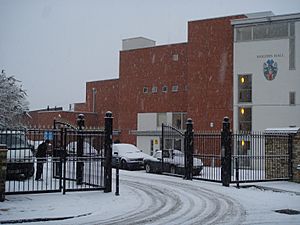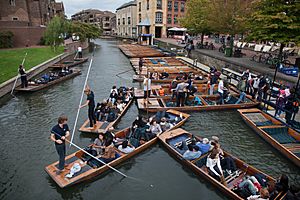Hughes Hall, Cambridge facts for kids
Quick facts for kids Hughes Hall |
||||||||||||||||||
|---|---|---|---|---|---|---|---|---|---|---|---|---|---|---|---|---|---|---|
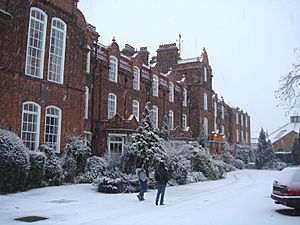
Margaret Wileman Building, Hughes Hall
|
||||||||||||||||||
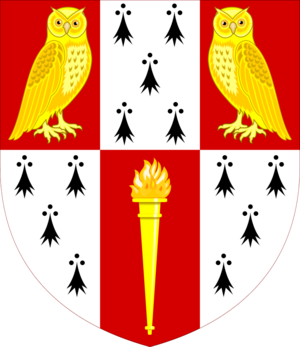
Arms of Hughes Hall
Blazon: Quarterly 1st and 3rd Gules an owl proper Or.; 5th Gules a torch proper Sable; 2nd, 4th and 6th Ermine |
||||||||||||||||||
|
|
||||||||||||||||||
| University | University of Cambridge | |||||||||||||||||
| Location | Mortimer Road (map) | |||||||||||||||||
| Full name | Hughes Hall in the University of Cambridge | |||||||||||||||||
| Abbreviation | HH | |||||||||||||||||
| Motto | Disce ut Servias (Latin) | |||||||||||||||||
| Motto in English | Learn in order to serve | |||||||||||||||||
| Established | 1885 | |||||||||||||||||
| Named after | Elizabeth Phillips Hughes | |||||||||||||||||
| Previous names |
|
|||||||||||||||||
| Sister college | Linacre College, Oxford | |||||||||||||||||
| President | Laurie Bristow | |||||||||||||||||
| Undergraduates | 201 (2022-23) | |||||||||||||||||
| Postgraduates | 775 (2022-23) | |||||||||||||||||
| Map | ||||||||||||||||||
| Lua error in Module:Location_map at line 420: attempt to index field 'wikibase' (a nil value). | ||||||||||||||||||
Hughes Hall is a college that is part of the University of Cambridge in England. It is the oldest college at Cambridge University that mainly focuses on postgraduate students. Postgraduate students are those who are studying for a master's degree or a PhD after finishing their first university degree.
The college also accepts undergraduates, who are students doing their first university degree. However, these undergraduates must be 21 years old or older. There is no age limit for postgraduate students. Most students at Hughes Hall are postgraduates. About one-fifth of the students are undergraduates aged 21 or older.
Hughes Hall was started in the 1800s. It was first called the Cambridge Training College for Women. Its goal was to train women graduates to become teachers. Over time, it grew and now supports many students and researchers. Both men and women study there, covering all subjects taught at the University of Cambridge.
The college has several buildings from the 19th and 20th centuries. It is located next to Fenner's, which is the Cambridge University Cricket Club ground. It is also between the city centre and the railway station.
Contents
History of Hughes Hall
In 1878, Cambridge University created a group to develop a teaching program. This program was for students who wanted to become teachers. Hughes Hall was founded in 1885 as a college for women graduates taking this teacher training course.
Some important people who helped start the college were Rev. G. F. Browne and Miss Frances Buss. Also involved were Miss Anne Clough and Professor James Ward.
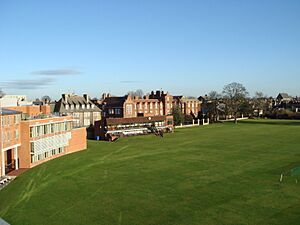
The college began as the Cambridge Training College for Women. It started with 14 students in a small house called Crofton Cottage. The first leader was Elizabeth Phillips Hughes (1851-1925). She was in charge from 1885 to 1899.
In 1895, the college moved to a new building. It was designed by William Fawcett and overlooked Fenner's cricket ground. This building is still the main college building today. One of the first students, Molly Thomas, wrote about her experiences. Her book was called A London Girl of the 1880s.
In 1947, women were allowed to become full members of the university. Because of this, the college became an official part of the university in 1949. It was then renamed Hughes Hall to honour its first principal, Elizabeth Hughes.
In 1985, the college became an approved foundation of the university. In 2006, it received a royal charter. This made it a full college of the university.
The first male students joined in 1973. This made Hughes Hall the first all-female college to accept men. From then on, students began to study many different postgraduate degrees. The number of students grew in the 1980s and 1990s.
Today, Hughes Hall has about 700 graduate students and 200 undergraduates. All students are "mature," meaning they are over 21 years old. The college supports study in all subjects taught at the university. It is one of the most international Cambridge colleges. Its students come from over 60 different countries.
College Buildings and Location
College Buildings
The main college building is called the Wileman Building. It was designed by William Fawcett and built in 1895. A politician named George Robinson, 1st Marquess of Ripon opened it. The building is a Grade II listed building. This means it is an important historical building. It is made of red brick and has a special terracotta porch.
One part of the Wileman Building is called the Pfeiffer Wing. It is named after Jurgen Edward Pfeiffer and Emily Jane Pfeiffer. They helped pay for much of the building. They wanted to support women's education. This building has student rooms, the college library, and social areas. It also has study spaces and college offices.
Next to the Wileman Building is Wollaston Lodge. This building was designed by Edward Schroeder Prior. It provides more rooms for students.
Newer buildings on the college site also offer rooms and facilities for students. These include Chancellor’s Court, opened in 1992 by Prince Philip, Duke of Edinburgh. The Centenary Building opened in 1997.
In 2005, Hughes Hall opened a new building called the Fenner's Building. It has rooms, a dining area, and meeting spaces. It is next to and overlooks the university cricket ground, also called Fenner's. From this building, you can see the spire of the Our Lady and the English Martyrs Church. This is the tallest church spire in Cambridge. The college also owns houses nearby for more student accommodation.
In 2014, the college bought the old Cambridge University gym building. It is across the cricket ground from the main college. The college started building new facilities there in 2015.
College Location
The main college site is close to the centre of Cambridge. It is halfway between Cambridge railway station and the Market Square. The college is in the Petersfield area of the city. It is near Mill Road and can be reached from Mortimer Road.
The main site is in a mostly residential area. It is next to the Fenner's cricket ground. Across the road are Parkside Pools and Kelsey Kerridge Gym. These are the main public sports facilities in the city. A short walk from the college is the Mill Road Cemetery. Many famous university figures are buried there. These include astronomer James Challis and historian John Seeley.
Getting Around
Hughes Hall is the closest college to Cambridge railway station. It is also near the main bus stop for long-distance coaches at Parkside. The easiest way to get to the centre of Cambridge for cyclists and walkers is across Parker's Piece. This is an open park where the rules of football were first written down in 1848.
Student Life at Hughes Hall
Students and teachers at the college take part in research and study. They cover all the different subjects taught at the University of Cambridge. Hughes Hall is known for being international and fair. The college does not have a special "high table" for teachers. Students can even walk on the college lawns.
The college was founded in the 1800s to support graduate study in education. This tradition continues today. Many students each year take courses in practical subjects. Others study traditional Arts and Humanities subjects. Since most students are postgraduates, undergraduates share facilities and ideas with PhD and MPhil students.
The college has its own boat called a punt. It is named "Buffyfish." Former graduate students built it and gave it to the MCR (Middle Combination Room, the graduate student common room).
Societies and Sports
Hughes Hall has many student sports teams. These include teams for Athletics, Badminton, Basketball, Cricket, Football, Rowing, Rugby, Squash, and Table Tennis. College members also play sports at university and national levels.
There are several college clubs and groups. These include a Chess Club, Film Society, Writing Group, and Law Society. The college's "Hat Club" holds events where students and teachers share their research. The Enterprise Society helps students who want to start their own businesses.
Music
The college's main place for performances is the Pavilion Room. It hosts many regular music groups. The Stradivari Trust and the Cambridge Graduate Orchestra use this space often. The college's Margaret Wileman Society also uses it. There are also student concerts and performances. The college choir, made up of students and teachers, also performs here.
Boat Club
Hughes Hall Boat Club is the college's rowing club. In 2003, it officially joined with the boat club of Lucy Cavendish College. They formed the "Hughes Hall/Lucy Cavendish Combined Boat Club."
The Club has done well in the May Bumps races. The men's first crew has won "blades" many times. Blades are given to a boat that bumps (overtakes) another boat every day of the races. The Club has won the Pegasus Cup three times. This cup is given to the most successful college boat club in the May Bumps. The women's first crew won blades for the first time in 2019.
Members of Hughes Hall are often chosen for the Cambridge team in the Oxford-Cambridge Boat Race. In 2015, three men from Hughes Hall were in the men's team. A woman from the college was the cox (the person who steers the boat) for the women's boat. In 2019, two members of the Cambridge Blue Crew were in the men's first crew for May Bumps.
The Boat Club keeps its six rowing boats at the Emmanuel College boathouse.
May Ball
Hughes Hall holds a May Ball every year. It often has a global or international theme. For example, in 2015, the theme was "Around the World in 12 Hours." In 2014, it was "Terra do Brasil."
Lectures and Talks
The college hosts many lectures and talks throughout the year. Some of the most important annual events are the City Lecture, the Kathleen Hughes Memorial Lecture, and the Honor Chapman Lecture.
The City Lecture invites speakers from the business world. It started in 2000. Past speakers include the editor of the Financial Times newspaper.
The Kathleen Hughes Memorial Lecture is given with the University of Cambridge Department of Anglo-Saxon, Norse and Celtic. Recent talks have been about early medieval sculptures.
The Honor Chapman Lecture started in 2014. The first two speakers were important women in law and business.
Notable Members
Principals/Presidents
The college's leader was called "Principal" until 1973. After that, they were called "President."
Principals
- 1885–1899: Elizabeth Hughes
- 1899–1902: Margaret Punnett
- 1902–1908: Helena Powell
- 1908–1933: Mary Hay Wood
- 1933–1945: Henriette Dent
- 1945–1953: Marguerite Verini
- 1953–1973: Margaret Wileman
Presidents
- 1973–1978: Sir Desmond Lee
- 1978–1984: Richard D'Aeth
- 1984–1989: Basil Herbertson
- 1989–1993: Desmond Hawkins
- 1993–1998: John Dingle
- 1998–2006: Peter Richards
- 2006–2014: Sarah Squire
- 2014–2022: Anthony Freeling
- 2022: Laurie Bristow
Fellows
- Nevin Hughes-Jones, a doctor who studies blood, Fellow of the Royal Society
- Neil Mercer, Professor of Education at the University of Cambridge
- Marc Weller, University of Cambridge Professor of International Law
Alumni
-
Andrew Murrison
A politician from the Conservative Party -
Annette Brooke
A politician from the Liberal Democrats -
Roxana Saberi
An American journalist
| Name | Birth | Death | Career |
|---|---|---|---|
| Gilberto Arias | 1960 | Former Ambassador of Panama to the United Kingdom | |
| Mary Brebner | 1858 | 1933 | A lecturer at Aberystwyth University who helped change language teaching in Britain. |
| Annette Brooke | 1947 | Former Liberal Democrats Member of Parliament (MP) | |
| Michael Gau | Vice Chairman of the Aviation Safety Council of the Republic of China | ||
| Theo Hobson | 1972 | British writer and theologian | |
| Anne Hollinghurst | 1964 | Bishop of Aston | |
| Damian Hopley | 1970 | England rugby player | |
| Mary Vivian Hughes | 1866 | 1956 | British educator and author. Her books share important information about women's education in the past. |
| Dorothy Jewson | 1884 | 1964 | A trade union organizer and politician. She was one of the first female Members of Parliament for the Labour Party. |
| Ian Lambert | 1960 | Principal of The Scots College, Sydney | |
| Alan Leong | 1958 | Member of the Hong Kong Legislative Council and Leader of the Civic Party | |
| Liam Mooney | 1972 | A businessman and entrepreneur based in Monaco. | |
| Paula Marcela Moreno Zapata | 1978 | Former Colombian Minister of Culture. | |
| Andrew Murrison | 1961 | Conservative Party MP and former government minister. | |
| Shane O'Mara | 1982 | American rower who represented the United States in international competitions. | |
| See Kee Oon | 1966 | Justice of the Supreme Court of Singapore. | |
| Chua Lee Ming | Justice of the Supreme Court of Singapore. | ||
| Eric Peters | 1969 | Scotland rugby player | |
| Tom Ransley | 1985 | British rower, World Champion and Olympic Bronze Medalist. | |
| Andy Ripley | 1947 | 2010 | England rugby player |
| Mark Robinson | 1974 | Former New Zealand rugby player. | |
| Roxana Saberi | 1977 | American journalist. She was held in a prison in Iran for 101 days. | |
| Gábor Scheiring | 1981 | Economist and Member of the Hungarian National Assembly. | |
| Chris Sheasby | 1966 | Former England international rugby union player, now a sports commentator and coach. | |
| Doreen Simmons | 1932 | 2018 | An English sumo commentator. She became known as "the voice of sumo wrestling" after moving to Japan. |
| Netta Syrett | 1865 | 1943 | English writer from the late Victorian period. |
| Choo Han Teck | 1954 | Justice of the Supreme Court of Singapore. | |
| Tony Underwood | 1969 | England rugby player | |
| Alison Uttley | 1884 | 1976 | British author of over 100 books. She is known for her children's series about Little Grey Rabbit. |
| Daniel Vickerman | 1979 | 2017 | Australian professional rugby union footballer. He played for the Wallabies. |
| Evan Wallach | 1949 | A judge in the United States and an expert on war crimes. | |
| Chan Seng Onn | 1954 | Justice of the Supreme Court of Singapore. |
Honorary Fellows
- Nigel Brown OBE, former chairman of N.W. Brown Group Ltd
- John Dingle, former Director of the Strangeways Research Laboratory and President of Hughes Hall
- Sir Terence English, a famous surgeon who did early organ transplants
- Hermann Hauser FRS, a pioneer in technology businesses
- John Hopkins, former Cambridge University Lecturer in Law
- Dame Cleo Laine, a famous jazz and pop singer and actress
- Peter Mansfield FRS, a physicist and Nobel Prize winner
- Nicholas Phillips, Baron Phillips of Worth Matravers, former President of the UK Supreme Court
- Dame Janet Smith, a former judge
- Evan Wallach, a judge in the United States
See also
 In Spanish: Hughes Hall para niños
In Spanish: Hughes Hall para niños


